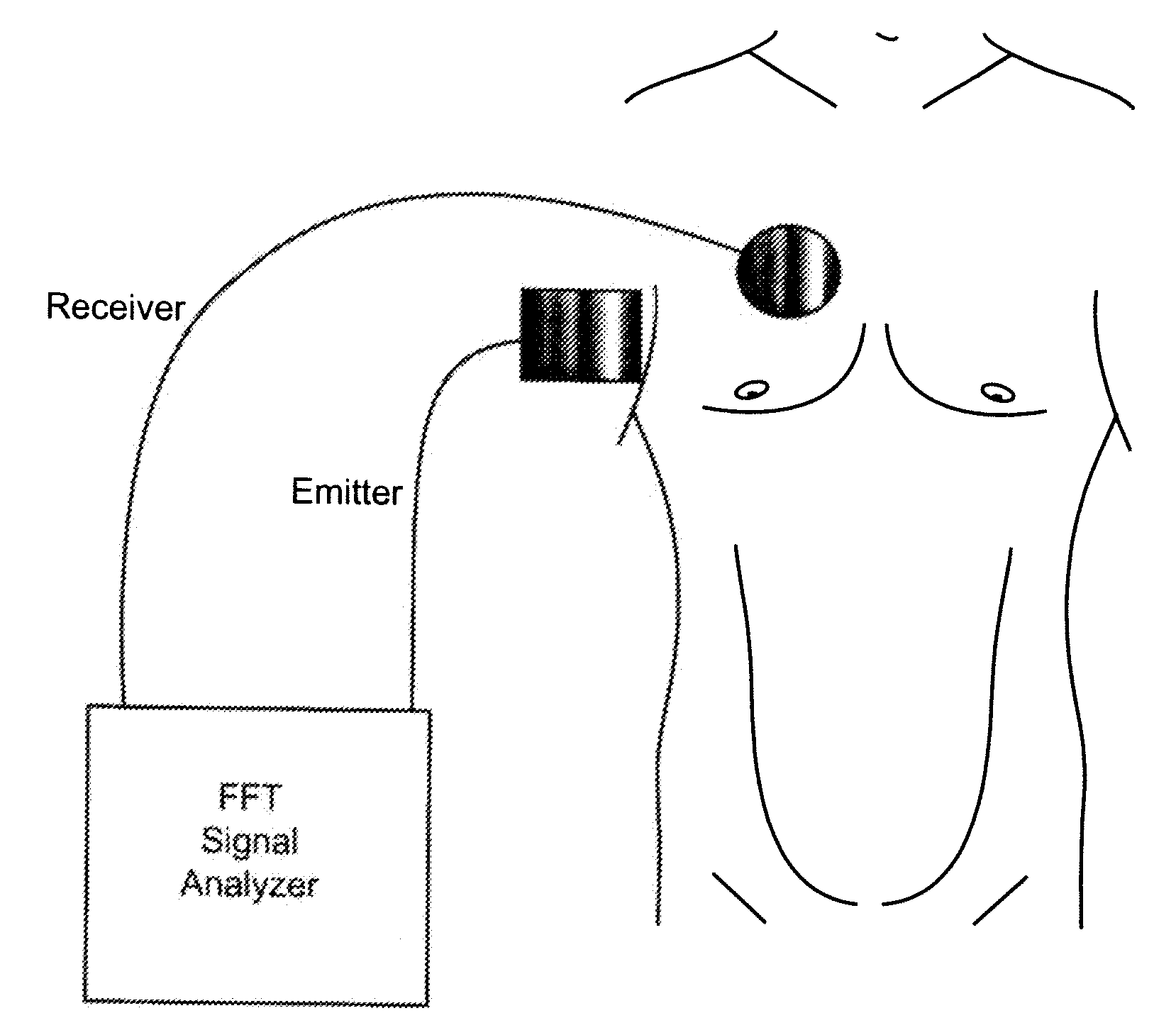Portable Pulmonary Injury diagnostic Devices And Methods
a pulmonary injury and portable technology, applied in the field of emergency medicine, can solve the problems of lungs collapse, rapid death from pulmonary injuries, injuries and deaths, etc., and achieve the effect of improving survival chances and minimal training and experien
- Summary
- Abstract
- Description
- Claims
- Application Information
AI Technical Summary
Benefits of technology
Problems solved by technology
Method used
Image
Examples
example 1
[0099]This Example uses a demodulating technique based on propagating an amplitude modulated (AM) signal in a non linear system as human soft tissue. Non parametric demodulation will result in the low frequency modulator and the carrier in the tissue. In this Example, a small transducer may be easily incorporated into a hand held architecture. The carrier in this Example is low frequency ultrasonic tones or low frequency ultrasonic noise. Frequencies between 25 and 50 kHz differentiate various induced fluid conditions in pig lung. The low frequency ultrasonic tones or low frequency ultrasonic noise (i.e., the stimulation) may be applied anywhere over the thorax. Preferably, the tracheal area is stimulated. Lung sounds may be recorded.
Low Frequency (>20 kHz) Ultrasound
[0100]Acoustic energy may be transformed into several other forms of energy, which may exist at the same time as heat, sonic and ultrasonic frequencies. When ultrasound is absorbed by tissue it produces alternate areas ...
example 1a
[0115]Assessment of Propagation Patterns: Fourier analysis was used to determine the spectra of signals with various transducer placements in a water / air simulated environment using a waveguide or tank.
[0116]Two female adult Hampshire pigs weighing about 50 kg were used in a pilot study of a lab version of the novel hand held battle field interthoracic device. The animal study was approved by the local vertebrate animal review board. Each pig was sedated with ketimine and pentobarbital. The stimulating sensor 20 and recording sensor 22 are depicted in FIG. 2. Vibratory probes (transmitter and receiver pair) were positioned around the chest to measure the acoustic properties of each normal chest / lung. Care was taken to avoid placing the ribs in the acoustic beam. Data was acquired using a real time spectral analyzer in the surgical suite and processed off line via MatLab program developed for quantification. Immediate spectra plots were available in the lab. Two other experimental co...
example 2
[0128]In this inventive example, a fast method and device capable of diagnosing pneumothorax uses high-frequency white noise sent through the chest cavity. The innovative portable pneumothorax detecting device of this example uses a transducer that emits a 10 Hz-50 kHz continuous band white noise sound. (FIG. 9) The pneumothorax detecting device generates vibro-acoustic wave frequencies, then transmits them from an emitter transducer to a receiver transducer located on the opposite side of the thorax. The receiving transducer, placed on the opposite side of the chest, senses the signal and sends the signal back to the real-time spectral analyzer for analysis. The spectral analyzer then computer the Fast Fourier Transform (FFT) on the signal and the result is displayed. The result indicates if pneumothorax or hemothorax is present. The velocity of the signal changes, due to attenuation, through different tissues inside the chest. When either air or fluid is present in the chest cavit...
PUM
 Login to View More
Login to View More Abstract
Description
Claims
Application Information
 Login to View More
Login to View More - R&D
- Intellectual Property
- Life Sciences
- Materials
- Tech Scout
- Unparalleled Data Quality
- Higher Quality Content
- 60% Fewer Hallucinations
Browse by: Latest US Patents, China's latest patents, Technical Efficacy Thesaurus, Application Domain, Technology Topic, Popular Technical Reports.
© 2025 PatSnap. All rights reserved.Legal|Privacy policy|Modern Slavery Act Transparency Statement|Sitemap|About US| Contact US: help@patsnap.com



